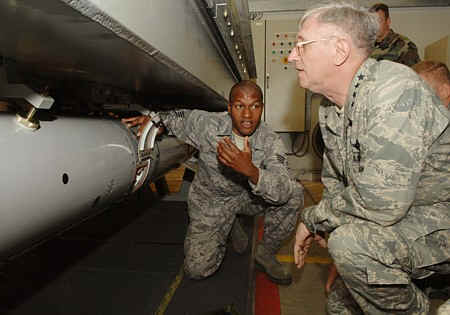The Cold War ended long ago, but the USA still
spends millions of dollars each year to keep 125-240 tactical
nuclear bombs at the ready in Europe. This has led to protests in
Europe, and open criticism by European leaders. Since nuclear missiles can be
launched from the USA or its submarines within minutes, why keep some at airbases in Europe? If something unexpected
suddenly arises, nuclear bombs can be flown in from
the USA within 24 hours.
The share-a-nuke practice developed during the Cold War, when the USA thought its NATO allies should join in nuclear war. American nukes were stored at their bases and maintained by American airmen, to be loaded onto German, Italian, Dutch, and Belgium aircraft during wartime to repel the Soviets. This game continues today, with USAF munitions squadrons overseeing nukes at NATO bases, and no one can say why this concept wasn't ended a decade ago. In June 2011, departing Secretary of Defense Bill Gates publicly said that storing these tactical nuclear bombs in Europe served no purpose and wasted resources. Gates knows that NATO wants to keep everything unchanged because its leaders are mostly concerned about keeping the billions of dollars in U.S. military spending flowing into their communities.
Status of U.S. Nuclear Weapons in Europe 2010
| Country | Airbase | USAF Unit | Delivery Aircraft | Tactical Nukes |
| Belgium | Kleine Brogel | 701 MUNSS | Belgian F-16s | 10-20 |
| Germany | Büchel | 702 MUNSS | German Tornados | 10-20 |
| Netherlands | Volkel | 703 MUNSS | Dutch F-16s | 10-20 |
| Italy | Ghedi Torre | 704 MUNSS | Italian Tornados | 20-40 |
| Germany | USAF Spangdahlem | 52d MMG | USAF F-15s | 0 |
| Turkey | USAF Incirlik | 39th ABW | USAF Fighters | 25-50 |
| Italy | USAF Aviano | 31st FW | USAF F-16s | 50-90 |
USAF - United States Air Force Airbase; FW – Fighter Wing; MMG –Munitions Maintenance Group; MUNSS –Munitions Support Squadron. Source: FAS
Some of these nukes are not kept on American airbases, but at allied airbases mostly guarded by ill trained and unmotivated NATO conscripts, something a 2008 Air Force study deemed unsafe. This outdated practice consumes American manpower and money to keep nuclear weapons ready for allied warplanes to quickly drop should "something" invade Europe. At an April 8, 2010 conference on the future of America's nuclear weapons, the Vice Chairman of the Joint Chiefs of Staff, General James Cartwright, was asked about the value of these weapons:
QUESTIONER: Yeah, let me follow up with a tactical nuclear weapons question. And I think General Cartwright's the one I want to ask. Obviously, our forward-deployed systems in Europe are -- it's a political-military issue. And I understand that the NPR did not want to prejudice the discussions underway at NATO. But if I can just separate the military for a moment, is there a military mission performed by these aircraft-delivered weapons that cannot be performed by either U.S. strategic forces or U.S. conventional forces?
CARTWRIGHT: No. (Scattered laughter.)
One may debate the value of keeping tactical nuclear weapons in Europe, but there is no reason to keep some stashed at four non-USAF bases. Each share-a-nuke site has around 150 full-time USAF personnel, with over 300 family members, and a hundred USAF civilian employees. The USAF pays for their ultra-expensive off-base housing, while transporting military children to distant English schools is costly. Kleine Brogel has its own DoD American elementary school! It may be reasonable to keep some tactical nuclear bombs at USAF bases at Aviano, Italy and Incirlik, Turkey. If the share-a-nuke practice is considered important to NATO, allied warplanes can fly to those airbases for exercises to practice loading dummy nukes and flying missions. Meanwhile, the few nuclear weapons stored at the four non-American airbases should be quickly removed, and the 52d Munitions Maintenance Group disbanded, along with its four dispersed squadrons.
Carlton Meyer editorG2mil@Gmail.com
©2011 www.G2mil.com